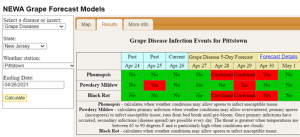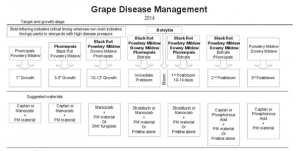Phomopsis disease of cane and leaf are prevalent throughout Northeastern and Mid-Atlantic region, including New Jersey. Most Vitis vinifera, and interspecific varieties are susceptible to this pathogen. The inoculum is carried in spring from over wintering sites by water onto susceptible tissues. In wet spring, grapevines staying wet for the longer duration following the bud break, is the right condition for the infection. Fruit and rachis infections can be severe if not controlled. Rachis susceptibility reduces few days after bloom. Berry infections remain inactive until preharvest, after which they colonize the fruit.
Symptoms:
Symptoms first appear three to four weeks following initial infection as tiny dark spots with yellowish margins on leaves and shoots. The shoot infections are characterized by numerous small black spots concentrated around the basal internodes. Under high disease pressure infections will manifest as cracks or fissures with potential breakage of the shoot or rachis. Infections during bloom can also result in rot of the ripe berries which resembles black rot (Figure 1).

Figure 1. Symptoms of Phomopsis infections on grapevine internodes (A); young leave (B); berries (C) and older cane and shoot (D). Photo Credit: James Travis, Penn State University.
Disease Forecast:
Based on NEWA (Network for Environment and Weather Applications) there was a forecast for the infection of Phomopsis, Black Rot and Powdery Mildew in most parts of New Jersey (Fig. 2). The conditions at the south jersey station (Elk Twp.) and North Jersey (Pittstown) were similar for that week. Regular monitoring grape disease forecast at http://newa.cornell.edu/index.php?page=grape-diseases can be an effective IPM strategy for timing fungicide sprays.

NEWA Grape disease forecast for Phomopsis and Black Rot, on April 30, 2021.
Growth Stage:
Currently most vinifera varieties are in 1” or greater growth stage. The example forecast indicates that vineyard with heavy disease/inoculum pressure highly likely to infect susceptible tissues and be prepared to spray one or more product at bud break even though it is not considered critical stage. In addition to continued spraying during the critical stages (Fig. 3). The growth rate of wine grape varieties varies, i.e. currently varieties like Ives, Chardonnay and Marquette are at 3″ to 4″ growth while others are bud swell to green tip, in southern NJ. Spray by varieties and do not wait for all varieties to show growth in order to spray entire vineyard at once, even if that may mean getting on to the sprayer every other day (personal communication, Jim Quarella).

Figure 3. Understanding the susceptibility of tissues for important grape diseases and most effective fungicides for controlling diseases.
Management:
- Phomopsis overwinters on last year’s canes. Therefore, pruning and removal help reduce initial inoculum. Pruned canes can be chopped or burned to inactivate these inoculum sources.
- Combining vineyard sanitation with a modest spray program provides effective control of the disease when inoculum pressure is medium to low.
- Cane pruning removes more of the inoculum than spur pruning.
- Considering the frequent cooler and wetter climate of New Jersey during the spring, it is advised to spray at least one preventive spray every year. However, fungicide application or spray program should be based on weather conditions (Fig. 2) and phenological stage (Fig.3), even if that means, spraying every few days!
- Lime Sulfur is somewhat effective in reducing but not eliminating overwintering inoculum when used as a delayed dormant or bud swell application.
- Only a few fungicides are effective against Phomopsis (Fig. 4) other fungicides are ineffective.
- Disease pressure in previous season should be considered when planning a management program.

Figure 4. Chemistry or mode of action, choices of fungicides, FRAC codes, risk for resistance important diseases of grapes.
Resources:
Klodd, A. 2019. Early Season Control of Phomopsis on Grapes.
NEWA (Network for Environment and Weather Applications), Cornell University.
Ward D., Majek B., Nielsen A., and Oudemans P. 2015. Commercial Grape Pest Control Recommendations for New Jersey. E283. Rutgers NJAES.
Wilcox W., Gubler W., and Uyemoto, J. 2015. Compendium of Grape Diseases, Disorders and Pests. 2nd Edition, APS Press

